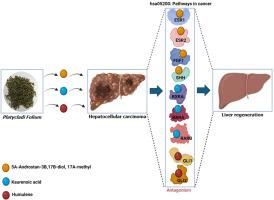A scheme to navigate “biomolecule X” from Platycladi Folium against hepatocellular carcinoma via phytoinformatics
IF 5
2区 医学
Q2 Medicine
引用次数: 0
Abstract
Background
Platycladi Folium (PF) is a natural herbal plant and a significant resource with anti-cancer agents, including hepatocellular carcinoma (HCC). In this study, we applied a phytoinformatics approach to identify potential therapeutic components for HCC treatment.
Methods
The target(s) of PF-derived molecules detected by gas chromatography-mass spectrometry (GC–MS) were relieved from reliable public bioinformatics databases (Similarity Ensemble Approach; SEA, and Swiss Target Prediction; STP), and HCC-responding targets were identified through human disease databases (DisGeNET, and OMIM databases). Holistically, PF-molecules-targets-mechanisms (PMTM) network was constructed to elucidate their therapeutic relationships. Next, molecular docking test (MDT) was conducted to obtain key molecule(s) on key target(s) in a key mechanism. The chemical reactivity level of the key molecule(s) was determined with density functional theory (DFT). Moreover, the toxicity of key molecule(s) was assessed using in silico platform.
Results
Ultimately, the 27 final targets were considered as significant targets, revealing in PPI network, then, ESR1 was a key modulator in the network. MDT revealed that 5A-Androstan-3B,17B-diol, 17A-methyl was bound most stably to ESR1, ESR2, FGF1, and Kaurenoic acid formed the most stable conformers with SHH, RXRA, RARA, and RARB. Then, Humulene had the strongest affinity on GLI1, and GLI2. The three molecules showed effective chemical reactivity in density functional theory (DFT), in parallel, they had no noticeable toxicity to develop as new agents.
Conclusions
Overall, our findings indicate that three biomolecules (5A-Androstan-3B,17B-diol, 17A-methyl; Kaurenoic acid; and Humulene) from PF have the potential to exert therapeutic effects on multiple targets in the ‘Pathways in Cancer’ pathway.

利用植物信息学方法从桔梗叶中寻找抗肝癌的“生物分子X”
背景:桔梗叶(platycladi Folium, PF)是一种天然草本植物,具有重要的抗癌药物资源,包括肝细胞癌(HCC)。在这项研究中,我们应用植物信息学方法来确定HCC治疗的潜在治疗成分。方法气相色谱-质谱(GC-MS)检测的pf衍生分子的靶点从可靠的公共生物信息学数据库(相似集成方法;SEA和Swiss target Prediction; STP)中解脱出来,并通过人类疾病数据库(DisGeNET和OMIM数据库)确定hcc响应靶点。整体上,构建了PF-molecules-targets-mechanisms (PMTM)网络来阐明它们之间的治疗关系。接下来,通过分子对接试验(MDT)获得关键机制中关键靶点上的关键分子。用密度泛函理论(DFT)确定了关键分子的化学反应水平。此外,在硅平台上评估了关键分子的毒性。结果27个最终靶点被认为是PPI网络中的重要靶点,表明ESR1是PPI网络中的关键调制器。MDT结果显示5a - androstan_3b,17B-diol, 17A-methyl与ESR1, ESR2, FGF1结合最稳定,而Kaurenoic acid与SHH, RXRA, RARA, RARB形成最稳定的构象。其次,Humulene对GLI1和GLI2的亲和力最强。在密度泛函理论(DFT)中,这三种分子均表现出有效的化学反应性,同时它们也没有明显的毒副作用。总之,我们的研究结果表明,PF中的3个生物分子(5a - androstanb - 3b、17B-diol、17A-methyl、Kaurenoic acid和Humulene)可能在“Pathways in Cancer”通路中对多个靶点发挥治疗作用。
本文章由计算机程序翻译,如有差异,请以英文原文为准。
求助全文
约1分钟内获得全文
求助全文
来源期刊

Translational Oncology
ONCOLOGY-
CiteScore
8.40
自引率
2.00%
发文量
314
审稿时长
54 days
期刊介绍:
Translational Oncology publishes the results of novel research investigations which bridge the laboratory and clinical settings including risk assessment, cellular and molecular characterization, prevention, detection, diagnosis and treatment of human cancers with the overall goal of improving the clinical care of oncology patients. Translational Oncology will publish laboratory studies of novel therapeutic interventions as well as clinical trials which evaluate new treatment paradigms for cancer. Peer reviewed manuscript types include Original Reports, Reviews and Editorials.
 求助内容:
求助内容: 应助结果提醒方式:
应助结果提醒方式:


